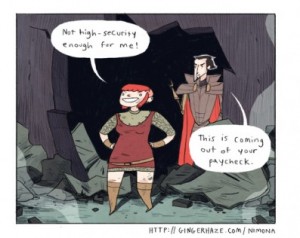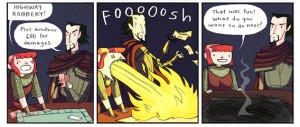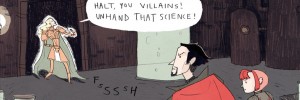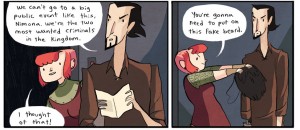 Welcome to Using Graphic Novels in Education, an ongoing feature from CBLDF that is designed to allay confusion around the content of graphic novels and to help parents and teachers raise readers. In this column, we examine graphic novels, including those that have been targeted by censors, and provide teaching and discussion suggestions for the use of such books in classrooms.
Welcome to Using Graphic Novels in Education, an ongoing feature from CBLDF that is designed to allay confusion around the content of graphic novels and to help parents and teachers raise readers. In this column, we examine graphic novels, including those that have been targeted by censors, and provide teaching and discussion suggestions for the use of such books in classrooms.
This post takes a look at Nimona by Noelle Stevenson, an award-winning graphic novel and a National Book Award Finalist.
Nimona is about a confident, occasionally snarky, and often inspiring shapeshifter named Nimona who ostensibly serves as supervillain Lord Ballister’s sidekick. Lord Ballister is a disfigured knight who must leave the Institution of Law Enforcement and Heroics after he loses his arm in a joust against Sir Ambrosius Goldenloin. Subsequently, he becomes an evil scientist. His only goals are to defame Sir Ambrosius Goldenloin and to expose and destroy the underhanded and dastardly deeds of the Institution of Law Enforcement and Heroics. Readers, however, soon find out that nothing is as it seems, not even Nimona. Not even good versus evil. Even more fascinating — and engaging — is that the more we read about Nimona and the more we see her in action, the less we know or understand about who or what exactly she is. All we know is that we are constantly rooting for her and can’t quite get enough.
Nimona has received numerous awards and recognition, including being named a National Book Award Finalist. It was nominated for a 2015 Eisner Award and received starred reviews from Kirkus, Publishers Weekly, School Library Journal, and The Bulletin of the Center for Children’s Books. It is also a New York Times Bestseller, and it was awarded Slate’s Cartoonist Studio Prize award. Fox Animation just recently acquired the rights to Nimona for a screen adaptation to be directed by Patrick Osborne.
Nimona originated as a two-page art school experiment, which was expanded into a webcomic that has won numerous fans and awards. The story is full of wonderfully balanced and baffling contradictions, from its characters to its settings to the very story itself. Nimona’s story takes place in a world of high-tech weapons and advanced science, a world in which society is run by kings, knights, and the Institute of Law Enforcement and Heroics. This world values science and magic and lives by rules. While we don’t live in that world, we understand it — until Nimona appears and shakes things up.
Reading Nimona is like sitting on the world’s greatest roller coaster. Throughout the book, we’re on the edge of our seats because of Nimona’s constant energy and her creative shapeshifting, and because of Stevenson’s constant twists and turns and perpetual surprises and contradictions. While it starts off as a story of fantasy filled with chivalry and humor, it turns into an intense story in which we learn that nothing is quite as it seems, except the power of love and friendship.
Themes embraced and boldly tackled in Nimona:
- Understanding one’s “identity,” the identity of others, and that identities are fluid;
- The tugs of friendship and rivalry between Sir Ambroise Goldenloin and Ballister Blackheart;
- The powers and perils of standards, rules, and stereotypes;
- The powers and perils of oligarchies, monarchies, and all-powerful institutions;
- The power of love and friendship;
- The need to question rules and standards.
SUMMARY
The story begins as Nimona enters supervillain Ballister Blackheart’s lab and introduces herself saying, “The Agency sent me. I’m your new Sidekick.” Ballister, however, doesn’t fall for this. It’s only once he sees Nimona shapeshift (into a shark with boobs) that he has any interest in working with her.
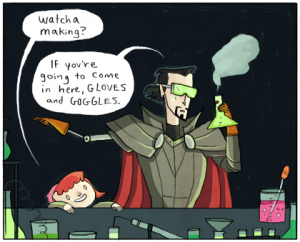 Initially, as Ballister and Nimona plot their misdeeds, Nimona appears to be a typical fantasy of magic, knights, mad science and shapeshifting. It appears to be a story of the petite, red-headed, shapeshifting Nimona and the evil, dark haired, goateed Blackheart’s quest to triumph over the blond, handsome, clean-shaven Sir Ambrosius Goldenloin and the Institution of Law Enforcement and Heroics that he champions. As the story unfolds, however, we realize that nothing is as we assume. Blackheart, for example, believes in science and in rules (which include not murdering or maiming innocents). Nimona, believes evil villains kill people “sometimes” and that, “No one’s gonna take you seriously if you’re too afraid to kill anyone.”
Initially, as Ballister and Nimona plot their misdeeds, Nimona appears to be a typical fantasy of magic, knights, mad science and shapeshifting. It appears to be a story of the petite, red-headed, shapeshifting Nimona and the evil, dark haired, goateed Blackheart’s quest to triumph over the blond, handsome, clean-shaven Sir Ambrosius Goldenloin and the Institution of Law Enforcement and Heroics that he champions. As the story unfolds, however, we realize that nothing is as we assume. Blackheart, for example, believes in science and in rules (which include not murdering or maiming innocents). Nimona, believes evil villains kill people “sometimes” and that, “No one’s gonna take you seriously if you’re too afraid to kill anyone.”
Numerous conflicts drive the story in Nimona. Conflicts exist between Nimona and Ballister, leading us to question who’s the evil villain and who’s the sidekick). Conflicts exist between Blackheart and Sir Goldenloin as they each respectively question their roles and their relationship. While Blackheart and Goldenloin were once close friends, after an “accident” during a joust, in which Sir Goldenloin shot off Ballister’s arm, Ballister realized that Goldenloin was no friend and that “the Institution had no use for a one-armed hero. I took the only other viable option.”
 As the story progresses, acts of mischief escalate into battles, and even though Nimona shares pieces of her past, we are no closer to understanding who she is. That, however, doesn’t stop us or even Ballister from finding something really, really endearing about her, even though she is the one who claims to be evil and wreaks havoc all around her.
As the story progresses, acts of mischief escalate into battles, and even though Nimona shares pieces of her past, we are no closer to understanding who she is. That, however, doesn’t stop us or even Ballister from finding something really, really endearing about her, even though she is the one who claims to be evil and wreaks havoc all around her.
Nimona is a smart, wonderfully fun romp through friendship, fantasy, expectations, and surprises. For example, Goldenloin’s first words in the book are, “Halt, you villains! Unhand that science!” While it initially feels a lot like Sunday funnies, Nimona quickly breaks the mold, replete with witches, poisoned (or at least germ-tainted) apples, jousts, rivalries, tavern brawls, dragons, magic, science, robots, and aliens. Furthermore, Stevenson’s art is as unique and quirky as Nimona herself. While the beginning of the book is rendered in somewhat simple tones, hues, and images, we see increasing depth to the images and the color palettes by the third chapter, and the images, the designs, the panel layouts take as many risks, jumps, and turns as Nimona herself as it progresses into its fifth chapter. Stevenson’s figures are quirky, with small, triangular heads and distinctive gestures. And while Blackheart and Goldenloin live in a world with rules and clear distinctions, Nimona opens it all up to questions, turning everything and everyone into a whole new ball of wax. Finally, while we all love Nimona for her spunk and snark, we also love Blackheart for his neverending faith in this creature who claims to be evil, but who we never quite believe.
This book is a great read for kids of all ages. I recommend you take the plunge, too. It’s exhilarating!
DISCUSSION SUGGESTIONS
Plot, Theme, and Character Development
- Plot and or discuss how Nimona, Ballister Blackheart, and Sir Ambrosius Goldenloin meet and supercede classic stereotypes. Discuss how Stevenson’s depiction of them provides clues about their character.
- Plot and or discuss how Nimona, Ballister Blackheart, and Sir Ambrosius Goldenloin grow together and apart as the story procedes.
- Create a Venn diagram representing how Blackheart and Goldenloin’s personalities, likes, and dislikes overlap. Discuss the similarities and differences between the two while discussing what makes theirs a solid “relationship.”
- Evaluate and discuss the Institute of Law Enforcements and Heroics’ “personality” and how Stevenson establishes it in the story.
Critical Reading and Making Inferences
- Define “good” versus “evil” and “hero” versus “villain.” Discuss how Stevenson relays these stereotypes and then breaks them.
- Discuss the role of killing and how different characters (Nimona, Blackheart, Goldenloin, and “the Institution”) use and/or justify it.
- Throughout the book, Ballister, Ambrosius, or Nimona bring up either their own rules or societal rules. In small groups or as a class, discuss the pros and cons of setting rules in various communities and circumstances. When is it appropriate to break rules and when is it not appropriate?
- Compare and contrast Nimona’s rules to Blackheart and Goldenloin’s rules. In what ways are they different, and why?
- Discuss Blackheart’s plan to expose the Institute. Is it okay to make people sick to expose a greater evil? Brainstorm other possible alternatives Blackheart might have followed.
- Discuss what Goldenloin meant on page 162 when he said, “We assumed she was a girl disguised as a monster, but she’s not. She’s a monster disguised as a girl.”
- Discuss the power of apologies (relating to pages 153-154) and Blackheart’s statement that, “You never said it before… don’t get me wrong, it’s not like I would have forgiven you. Still, it’s a relief I suppose.”
Language, Literature and Language Usage
- Compare and contrast this story to classic stories of knights, chivalry, and fantasy. How is it similar to these other works? How is it different? How are these differences beneficial?
- Discuss the names Stevenson gives her characters. What might they tell us about the characters? Discuss the power of names.
- Throughout the story, Stevenson often makes interesting and atypical word choices. Search for and discuss these word choices. For example:
- Discuss why Blackheart calls Nimona his sidekick, while Goldenloin calls her “squire.” Why do they use two different terms, and how does that help add depth to the story?
- On page 127, Stevenson writes, “Do we have an accord?” Discuss her use of “accord” instead of “agreement.”
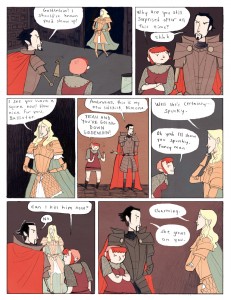 Modes of Storytelling and Visual Literacy
Modes of Storytelling and Visual Literacy
- Chart and evaluate Nimona’s choices when shapeshifting. Discuss how Stevenson pairs the image and text when Nimona shapeshifts to help create depth and humor.
- Discuss how Stevenson uses color to help her tell her story. Discuss the palates she uses for Nimona, Blackheart, Goldenloin, the Institute, the street. What do these color choices tell us about the characters and places?
- Discuss Stevenson’s use of occasional black and white panels. How does this help her tell the story?
- Chart, evaluate, and discuss the use of visual symbolism and stereotypes. For example:
- The differences in how Stevenson depicts Blackheart versus Goldenloin;
- The animals Nimona chooses to shift into;
- On page 25, Nimona talks about her childhood, and Stevenson shows her in a red cape as she tells Blackheart, “Then one day I was gathering berries in the woods…” Discuss how/why she resembles Little Red Riding Hood.
- Discuss Nimona’s transformation choices as she goes from guard to ugly witch with a wormy apple on pages 53-55.
- Discuss the veracity of Goldenloin’s statement on page 162, as he tells his boss at the Institute why he couldn’t kill Nimona, “You didn’t see what I saw. You didn’t see her face… What are you going to do? You can’t FIGHT her…” Discuss how “seeing a face” adds information that often can’t be described.
- Lumberjanes by Shannon Walters, Grace Ellis, and Noelle Stevenson — about five spunky girls and their adventures with boys, one awesome counselor, and supernatural beings while at summer camp.
- I Kill Giants by Joe Kelly and JM Ken Niimura — about an eleven-year-old girl who struggles to face and understand an untimely loss, first through escapism and then gradually through acceptance.
- Nothing Can Possibly Go Wrong by Prudence Shen and Faith Erin Hicks — full of unlikely friendships and wonderfully nuanced characters where science/robotics geeks versus Athletes and cheerleaders bend and shatter stereotypes and expectations in a delightful contest of wills.
- Ms. Marvel by G. Willow Wilson and Adrian Alphona, about a sixteen-year-old girl from Jersey City, New Jersey who becomes the new Ms. Marvel.
- His Dark Materials Trilogy by Philip Pullman — about a girl, a boy, alternate worlds, and an evil institution.
Common Core State Standards Common Core State Standards (CCSS)
As this book can be used for middle grades and older, when discussing how this book meets CCSS, I will be using the Common Core Anchor Standards for College and Career Readiness for Reading, Writing, and Speaking and Listening to help guide interested educators:
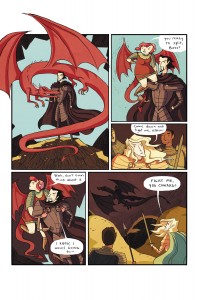 Knowledge of Language: Apply knowledge of language to understand how language functions in different contexts, to make effective choices for meaning or style, to comprehend more fully when reading or listening.
Knowledge of Language: Apply knowledge of language to understand how language functions in different contexts, to make effective choices for meaning or style, to comprehend more fully when reading or listening.
- Vocabulary Acquisition and Use: Determine or clarify the meaning of unknown and multiple-meaning words and phrases by using context clues, analyzing meaningful word parts, and consulting general and specialized reference materials; demonstrate understanding of figurative language, word relationships, and nuances in word meaning; acquire and use accurately a range of general academic and domain-specific words and phrases sufficient for reading, writing, speaking and listening at the college and career readiness level.
- Key ideas and details: Reading closely to determine what the texts says explicitly and making logical inferences from it; citing specific textual evidence when writing or speaking to support conclusions drawn from the text; determining central ideas or themes and analyzing their development; summarizing the key supporting details and ideas; analyzing how and why individuals, events, or ideas develop and interact over the course of the text.
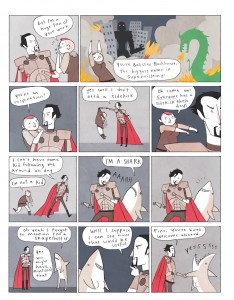 Craft and structure: Interpreting words and phrases as they are used in a text, including determining technical, connotative, and figurative meanings and analyzing how specific word choices shape meaning or tone; analyzing the structure of texts, including how specific sentences, paragraphs and larger portions of the text relate to each other and the whole; Assessing how point of view or purpose shapes the content and style of a text.
Craft and structure: Interpreting words and phrases as they are used in a text, including determining technical, connotative, and figurative meanings and analyzing how specific word choices shape meaning or tone; analyzing the structure of texts, including how specific sentences, paragraphs and larger portions of the text relate to each other and the whole; Assessing how point of view or purpose shapes the content and style of a text.
- Integration of knowledge and ideas: Integrate and evaluate content presented in diverse media and formats, including visually…as well as in words; delineate and evaluate the argument and specific claims in a text, including the validity of the reasoning as well as the relevance and sufficiency of the evidence; analyze how two or more texts address similar themes or topics in order to build knowledge or to compare the approaches the authors take
- Range of reading and level of text complexity: Read and comprehend complex literary and informational texts independently and proficiently
- Research to Build and Present Knowledge: Conduct short as well as more sustained research projects based of focused questions, demonstrating understanding of the subject under investigation; gather relevant information from multiple print and digital sources, assess the credibility and accuracy of teach source, and integrate the information while avoiding plagiarism; draw evidence from literary or informational texts to support analysis, reflection, and research.
- Comprehension and collaboration: Prepare for and participate effectively in a range of conversations and collaborations with diverse partners, building on others’ ideas and expressing their own clearly and persuasively; integrate and evaluate information presented in diverse media and formats, including visually, quantitatively and orally; evaluate a speaker’s point of view, reasoning, and use of evidence and rhetoric.
- Presentation of knowledge and ideas: Present information, findings, and supporting evidence such that listeners can follow the line of reasoning and the organization; adapt speech to a variety of contexts and communicative tasks, demonstrating command of formal English when indicated or appropriate.
Links and Resources:
- Preview Nimona here: http://gingerhaze.com/NIMONA
- View Stevenson reading a section of Nimona as a presenter at the National Book Awards here: http://www.nationalbook.org/nba2015_ypl_stevenson.html – .Vl3GUcpX83g
- You may want to critique how she reads the book aloud and brainstorm other ways to read it aloud.
- For an interview with Noelle Stevenson discussing role of women in comics and film, please visit: http://www.vanityfair.com/culture/2015/07/noelle-stevenson-nimona-lumberjanes-comic-con-eisner-awards
Meryl Jaffe, PhD teaches visual literacy and critical reading at Johns Hopkins University Center for Talented Youth Online Division and is the author of Raising a Reader! and Using Content-Area Graphic Texts for Learning. She used to encourage the “classics” to the exclusion comics, but with her kids’ intervention, Meryl has become an avid graphic novel fan. She now incorporates them in her work, believing that the educational process must reflect the imagination and intellectual flexibility it hopes to nurture. In this monthly feature, Meryl and CBLDF hope to empower educators and encourage an ongoing dialogue promoting kids’ right to read while utilizing the rich educational opportunities graphic novels have to offer. Please continue the dialogue with your own comments, teaching, reading, or discussion ideas at meryl.jaffe@cbldf.org and please visit Dr. Jaffe at http://www.departingthe text.blogspot.com.
We need your help to keep fighting for the right to read! Help support CBLDF’s important First Amendment work by visiting the Rewards Zone, making a donation, or becoming a member of CBLDF!
All images (c) Noelle Stevenson
